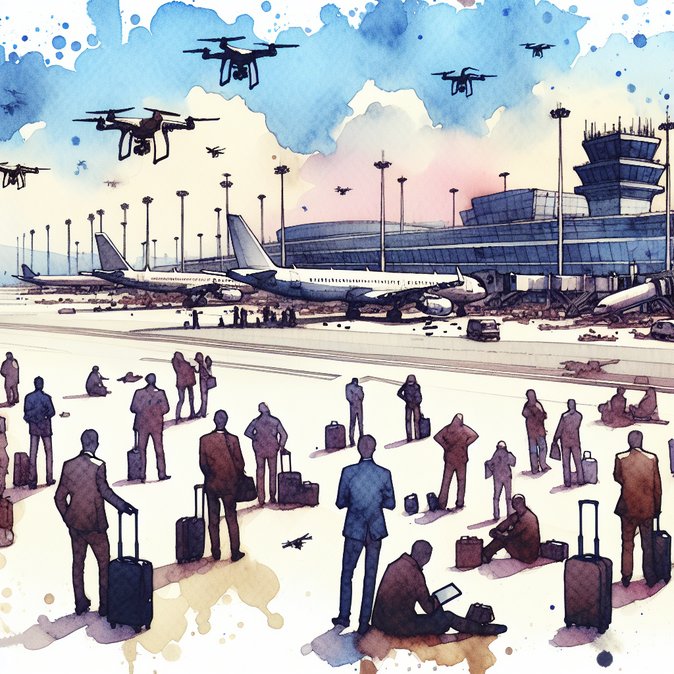
Belgium’s two busiest passenger hubs – Brussels-Zaventem and Charleroi – ground to a halt late on 4 November after air-traffic controllers received multiple alerts of unmanned aerial vehicles inside controlled airspace. Operations remained suspended into the early hours of 5 November while the Federal Police and the air-navigation service provider Skeyes deployed mobile radar and infrared teams to verify the reports.
By sunrise on 5 November, some 80 flights had been cancelled and a further 60 re-routed, leaving an estimated 400-500 passengers sleeping on terminal floors or in hastily-arranged hotel accommodation. Brussels Airport spokesperson Ariane Goossens told AFP that services would “return to normal during the course of the day,” but warned of rolling delays as aircraft and crews were repositioned. Charleroi, a key low-cost gateway for Ryanair and Wizz Air, restarted departures shortly after 09:00 but advised travellers to arrive three hours early while security sweeps continued.
![Drone sightings force overnight shutdown of Brussels & Charleroi airports, stranding 500 travellers]()
The shutdown underscores the vulnerability of major hubs to inexpensive consumer-grade drones. Brussels handles more than 70,000 connecting passengers a day; any prolonged closure ripples through intra-European corporate travel itineraries, air-cargo flows, and crew rotations. Freight forwarders reported missed connection windows for pharmaceuticals and time-sensitive perishables bound for Africa, while several multinationals diverted executives to Paris-CDG and Düsseldorf at short notice, incurring extra hotel and ground-transport costs.
Under Belgian law, entering airport airspace with a drone can trigger prison terms of up to five years and fines of €100,000. Industry bodies are urging faster deployment of counter-UAS technology. “Incursions of just a few minutes can cost airlines six-figure sums and erode confidence in Brussels as a reliable hub,” said Pierre Van den Broeck of the Board of Airline Representatives. Skeyes confirmed it will accelerate installation of fixed radio-frequency detection towers before the Entry/Exit System (EES) goes live in October 2025, when passenger volumes are forecast to rise.
For global-mobility managers the episode is another reminder to build redundancy into duty-of-care plans, including rail alternatives such as Eurostar and Thalys and dual-ticket strategies on short-haul sectors. Travel management companies reported a 38 percent spike in same-day rail bookings between Brussels and Paris on 5 November.
By sunrise on 5 November, some 80 flights had been cancelled and a further 60 re-routed, leaving an estimated 400-500 passengers sleeping on terminal floors or in hastily-arranged hotel accommodation. Brussels Airport spokesperson Ariane Goossens told AFP that services would “return to normal during the course of the day,” but warned of rolling delays as aircraft and crews were repositioned. Charleroi, a key low-cost gateway for Ryanair and Wizz Air, restarted departures shortly after 09:00 but advised travellers to arrive three hours early while security sweeps continued.

The shutdown underscores the vulnerability of major hubs to inexpensive consumer-grade drones. Brussels handles more than 70,000 connecting passengers a day; any prolonged closure ripples through intra-European corporate travel itineraries, air-cargo flows, and crew rotations. Freight forwarders reported missed connection windows for pharmaceuticals and time-sensitive perishables bound for Africa, while several multinationals diverted executives to Paris-CDG and Düsseldorf at short notice, incurring extra hotel and ground-transport costs.
Under Belgian law, entering airport airspace with a drone can trigger prison terms of up to five years and fines of €100,000. Industry bodies are urging faster deployment of counter-UAS technology. “Incursions of just a few minutes can cost airlines six-figure sums and erode confidence in Brussels as a reliable hub,” said Pierre Van den Broeck of the Board of Airline Representatives. Skeyes confirmed it will accelerate installation of fixed radio-frequency detection towers before the Entry/Exit System (EES) goes live in October 2025, when passenger volumes are forecast to rise.
For global-mobility managers the episode is another reminder to build redundancy into duty-of-care plans, including rail alternatives such as Eurostar and Thalys and dual-ticket strategies on short-haul sectors. Travel management companies reported a 38 percent spike in same-day rail bookings between Brussels and Paris on 5 November.










